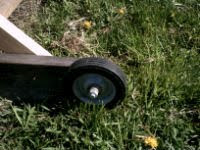The Wheat is coming up... I think. It's hard to tell. The spot where I planted it was never completely cleared of the swamp grass that had been there for 30 years so they are both coming in pretty well. I hope to be able to tell the difference in a few weeks and try to cut the swamp grass down a bit and let the wheat grow above it. The swamp grass makes for good hay so it won't be a total loss if it chokes the wheat a bit. But it's going to be harder to thresh the wheat out.
All it's done for the last week is rain rain rain. That's good for the plants we have in, but I'd like to have put in a few more crops this week. I'll have to wait until the ground dries a little to get in the carrots and beats. They are hard enough to plant when the ground is dry, it's just a sticky mess when the field is mud.
First week of June the corn goes in, and so do some of the squash. Sunflowers can go in too if there is time. Peas are in, and seem to be coming up.
that's about it for now.
-dale
O.K. I.v been a slacker.....
15 years ago






